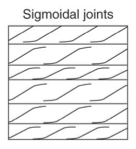![]()
![]()
![]()
Use LEFT and RIGHT arrow keys to navigate between flashcards;
Use UP and DOWN arrow keys to flip the card;
H to show hint;
A reads text to speech;
51 Cards in this Set
- Front
- Back
|
Formula for extension? |
Lf-Lo/Lo |
|
|
Formula for stretch? |
Lf/Lo |
|
|
Formula for quadratic elongation? |
(Lf/Lo)^2 |
|
|
Homogenous strain |
Lines that were straight before must be straight after, rotation can occur. |
|
|
Coaxial strain |
Pure shear. Finite stretching directions are the same before and after deformation. |
|
|
Displacement field |
Shows the start and finish points of the particles. |
|
|
Particle path |
Gives you the whole path of the particles. |
|
|
Non-coaxial strain |
Simple shear. Finite stretching axis are not the same after deformation. |
|
|
Angular shear |
Change in angle between two angles that were perpendicular. |
|
|
Shear strain |
The tangent of the angular shear angle. |
|
|
Rf method |
Set up internal coordinate system, get a 3d ellipsoid. |
|
|
The fry method |
Good for fine-grained rocks |
|
|
Flynn diagram |
y axis is x/y x axis is y/z |
|
|
Flynn Diagram: Field of Flattening |
X, y, z shorten |
|
|
Flynn Diagram: Field of constriction |
Z, y shorten. X gets bigger |
|
|
Flynn Diagram: Plane strain |
X grows, y stays the same, z shortens |
|
|
Flynn Diagram: 6:2:1 |
X:Y = 6/2 = 3 Y:Z = 2/1 = 2 |
|
|
Most important process is shaping shear zones |
Simple Shear |
|
|
Strain Rate |
(Lf-Lo/Lo)/seconds Contraction - Extension + |
|
|
Volume increase? Decrease? |
- Veins -Stylolites, pressure solution |
|
|
Continuous strain |
Ex: Folding |
|
|
Discontinuous strain |
Broken up |
|
|
Four mechanisms of Rheology |
1) Elastic: Recoverable, instantaneous 2) Plastic: Non-recoverable, breaks bonds 3) Viscous: Non-recoverable, accumulates w/ time 4) Nonlinear viscosity: Non-recoverable |
|
|
Viscoelastic behavior |
Strain is recoverable but its accumulation and recovery is delayed. |
|
|
Elastico-viscous behavior |
Material behaves elastically but then behaves viscously. When stress is removed only the elastic component is recovered. |
|
|
Tensile strength |
Stress required to rupture bonds in tension |
|
|
What is a preferred orientation for slip? |
Cleavage, or a slip plane. |
|
|
Three types of crystal defects |
Point defects |
|
|
Brittle Deformation |
The permanent change that occurs in a solid material due to the growth of fractures and/or due to sliding on fractures. |
|
|
Why do cracks propogate? |
Huge stresses at crack tips |
|
|
Griffith Cracks |
Preexisting microcracks and flaws in a rock that when stresses are applied, grow and intersect other cracks. |
|
|
Crack Mode 1 |
Tensile-mode cracks |
|
|
Crack Mode 2 |
Sliding |
|
|
Crack Mode 3 |
Tearing |
|
|
Shear Fracture |
A fracture that grows in association with a component of shear |
|
|
Cataclastite |
Fault rock comprised of rock fragments of various sizes set within a fine matrix.
|
|
|
Joint |
A fracture that forms by tensile-loading. Planar and often smooth. |
|
|
Plumose structure |
On joints, resembles an imprint of a feather, due to inhomogeneity of rock. |
|
|
Why are plumose structures more prominent away from the origin? |
This is due to stress concentration at crack tips. |
|
|
Types of plumes |
Straight, curvy, cyclical plume (lots of start-stop) |
|
|
Twist Hackle |
A twisted joint. Occurs when a fracture tip grows and must rotate with changing stress. Often occurs in the "Hackle Fringe". |
|
|
Systematic Joints |
Planar joints that comprise a family of joints that are all parallel and maintain the rough spacing. |
|
|
Nonsystematic Joints |
Joints that aren't parallel or evenly spaced. |
|
|
Joint Set |
A group of systematic joints. |
|
|
Conjugate joints |
60 degree, 120 degree angles |
|
|
Sigmoidal |

|
|
|
Three mechanisms that contribute to joint formation during uplift & erosion: |
1) Contraction during cooling 2) Poisson effect: rock expands vertically and contracts horizontally during unloading 3) Membrane effect: expansion due to increase in curvature of layer |
|
|
Cooling joints |
Form by thermal contraction |
|
|
Exfoliation joints |
Form by unloading of bedrock through erosion, form parallel to topography |
|
|
Tectonic joints |
Form by tectonic stresses |
|
|
En echelon tension gashes |
Form 45 degrees from plane of max shear stress Tails are parallel to the direction of principal stress |

